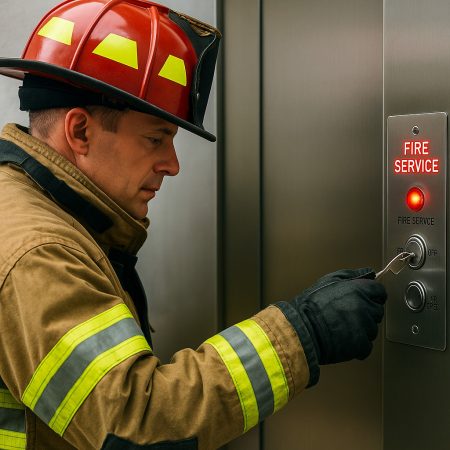Procedures are outlined in the Code.
by Max Stanley
A17.4 2015 is a guide for emergency personnel seldom visited by those responding to elevator entrapments or the operation of firemen’s service phase I & II. The A17.1 Code defines who emergency personnel are and those keys and devices they should have access to during an emergency. A17.1 2022 definitions:
Emergency personnel: persons who have been trained in the operation of emergency or standby power and Firefighters’ Emergency Operation or emergency evacuation. A17.1 2022 2.12.6.2.4 (j)
Learning Objectives
After reading this article, you should be able to:
- Know the location of and have access to the Group 1-3 keys and devices including the machine room and the machine room key.
- Identify and confirm that the stalled elevator is de-energized.
- Follow the rescue procedures of the A17.4 Guide for Emergency Personnel.
- Follow the rescue plan.
- Have the proper equipment for the landing and the machine room procedures.
Hoistway door unlocking device (Shall also be made available to emergency personnel during an emergency). A17.1 2022 8.1.1 Keys are to operate only Group 1, 2, 3 or 4 devices. 8.1.2 Group 1 (keys) Restricted to elevator personnel except
(i) emergency access doors
(j) hoistway door unlocking device
8.6.1.2.2 (8) (e) (1)
(1) evacuation procedures for elevators by authorized persons and emergency personnel shall be available on-site (see 8.6.11.5.2 and ASME A17.4) These are the reasons from a Code standpoint that emergency personnel should be instructed or trained and have access to the devices and keys necessary to perform during an emergency.
It is required by A17.1 8.6.11.5.2-6 that emergency personnel have a written emergency plan in place, accessible and on-site that is equipment specific. Those persons who are designated as emergency personnel shall be given a copy of the plan. A list of those emergency personnel shall be accessible on-site to the AHJ.
A17.4 is, as the title states, a guide for emergency personnel. This is not an exhaustive Code, nor can the details of all of the variables or possible job-site hazards be included lest this become so complex and voluminous as to defeat its purpose of providing a guide for emergency personnel who are not experienced elevator technicians.
A17.4 Guide for Emergency Personnel 2015
Your author teaches a class regarding A17.4, which is presented in two parts. First, the PowerPoint presentation of the Code text. Then, a question-andanswer period is provided to clarify any misunderstandings about the elevator in general or why the elevator operates the way it does when in phase I and II firemen’s service. The second part of the class is a hands-on application of both elevator rescue and firemen’s emergency service operation.
The forward of the A17.4 Code answers why it was written. Essentially, it was a response to a demand from building owners, lessees and operating managements as a guide for the evacuation of passengers from a stalled elevator by building personnel who are carefully selected and trained so that they might respond in a timely fashion. These building staff members are then recorded as a list of emergency personnel. It is highly recommended that evacuation of passengers from elevators be performed under the direct supervision of elevator personnel; however, the situation may call for an immediate response.
Value: 1 contact hour (0.1 CEU)
This article is approved for Continuing Education by NAEC for CET®, CAT® and QEI.
EW Continuing Education is currently approved in the following states: AL, AR CO, FL, GA, IL, IN, KY, MD, MO, MS, MT, NJ, OK, PA, UT, VA, VT, WA, WI and WV | Canadian Province of BC & ON. Please check for specific course verification of approval at elevatorbooks.com.
The A17.4 Code was written with participation from the elevator industry and the National Fire Protection Association. In many cases of entrapment, building personnel and firemen are the first responders. This Code is a written guide for firemen, as well as trained building personnel. Some of the procedures outlined in the Rescue section of this Code are for rescue and fire department (RFD) personnel only. These procedures will be noted in this article.
I need to say that, when a client engages me to present the A17.4 class, a visit to the site of the class is made to ensure reasonable success when the rescue process is presented. The hoistway door interlock release and door restrictor(s) are tested, and fire recall phase I & II are operated. These examinations are performed so class attendees will be working with an elevator that is operating correctly. Often the keys needed to access the machine room, fire service and stop switch are not on-site, the door locks are not adjusted properly and the required logs for verifying phase I & II operation are not on-site. The client is sent a list of questions about job-site conditions regarding the access to the proper tools, keys and uninterrupted use of the elevator during the class presentation.
Once these housekeeping issues have been addressed, the class can proceed with some expectation of success.
Introduction
The introduction to A17.4 is very explicit in its recommendations. It is always best that any evacuation be performed under the supervision of an elevator technician. However, the situation may call for an immediate response. I have called on elevator service providers; the automated administrative opening tells you to call the local fire and rescue department in the case of an emergency.
Elevator technicians have experience and knowledge of the controls. In some situations, the technician may be able to safely move the elevator to a landing to allow egress through the landing door.
The introduction also advises that trained elevator technicians follow the same procedures outlined in this Code. Their familiarity with equipment-specific design and operation adds greatly to the safety and success of any rescue.
Organizing Teams
The building owner must select and train their staff in proper evacuation procedures. It is highly recommended that two members of a team respond to any entrapment call. The role of each team member must be known in advance of any rescue attempt. One team member will be stationed outside the stalled elevator. The second team member will be stationed in the machine room. It is therefore best that the persons selected to be team members know both roles. If the building has occupants 24 h of a day, the teams need to be available to respond accordingly. If having teams of emergency personnel during all shifts is not possible, then given that the elevator telephone must be answered 24/7 by a call center, the responders should be given instruction to call the local fire and rescue after hours. Fire and rescue teams need to be trained, as well.
The list of tools needed to prepare for an evacuation attempt can be broken into two groups.
First, emergency personnel that the building owner or management has designated and trained in emergency operation of the elevators in the facility. Such emergency personnel staff should be limited to rescues through the hoistway doors within 3 ft of the landing. Beyond this distance from the landing, the rescue becomes a cartop type of process.
Although 3 ft is the extreme limit in the Code text, it can be impractical beyond the leveling zone of >18 in. Beyond this distance from the landing, the door restrictive device may not be accessible. Then, too, depending on the occupants and their condition, the attempt at removal may require physical exertion beyond the team’s abilities. Building management often has a specific policy regarding the maximum distance the elevator can be from the landing, beyond which they should not proceed with attempting a rescue.
List of Tools for Building Staff Authorized To Perform Rescues
- Flashlight
- Hoistway door unlocking “keys” (Training required by A17.1 8.6.11.5.4 before issuing or using.)
- Lockout/tagout equipment (hasp and lock, breakers require special device to allow locks.)
- Two-way communication devices (cell phones or radios, test between machine room/landing of the stalled elevator)
- *Although not called for, I stress the need for barricades with cautionary signage and yellow panels. The primary purpose is to establish an area needed for the rescue at the landing anytime the hoistway door is more than 6 in. opened from locked position)
- Door wedge tool (to keep the hoistway door reel closer from creating a nuisance)
Fire and rescue are a second grouping with an additional set of equipment needed for a cartop rescue. As the elevator is more than 3 ft from the landing, this process is more complex and the potential for safety concerns is far greater. The removal of trapped passengers through the escape hatch in the elevator canopy should only be performed as a last resort. The need for following the procedure outlined in A17.4 cannot be stressed enough.
Fire Rescue Tools for Cartop Evacuation in Addition to the Above List
- Ladders
- Fall Devices (emergency personnel entering the hoistway and for the trapped riders, as each is extracted)
- Lifelines (usually a lanyard that can be attached to fixed cartop equipment such as the crosshead)
- Forcible entry tools
- Polling tools
Training and Instruction of RFDs
Local RFD teams should be given training in the proper procedures for evacuating passengers as required by A17.1 section 8.6.11.5.4 at every building within their jurisdiction. The Code says that RFDs should take advantage of local elevator maintenance providers in their familiarity and training. Many elevator companies will not provide this training.
Once the training has been provided, rescue drills should be held on a routine basis. This is to refresh the team members on procedures, perform a tool check, check the expiration dates on fall devices and, in general, perform an inventory of needed tools as they have a way of being misplaced or borrowed.
Insofar as both building emergency personnel and rescue RFD teams are concerned, both should have written instructions to follow for each individual team member. These instructions should be clear and concise, providing a step-bystep outline of the actions to be taken, as well as telephone numbers to be contacted for assistance, e.g., elevator maintenance personnel. For the proper location of the keys in the building, each key should be labeled. Copies of the A17.4 Code are available to meet the instruction requirement of A17.1.
Lockout/Tagout Procedures
Each organization, building staff and RFD should also have a written procedure to lockout and tagout the elevator power source. Once the team has established that the power needs to be removed throughout the rest of the evacuation, the disconnect should be pulled or switched to the off position, and the hasp and lock should be installed. Some elevators have a breaker switch for the power source. Be sure to have the mechanical interlock needed to secure the breaker switch in the off position.
It is very important to test that the power has been removed from the elevator involved in the rescue. The team member at the elevator should talk with the occupants, asking them to push the floor buttons and door open buttons, looking to see if the floor position indicator is still lit. If the buttons light up or the indicator continues to shine, the power has not been removed.
In the event that the machine room cannot be located or accessed, then unless the power is removed, the rescue attempt should be stopped. Gaining control of the stalled elevator is the most important aspect of the rescue procedure.
The advent of machine-room-less (MRL) units has made identifying the power source more difficult. The controllers are often located in the door jamb on a terminal floor. Unless the responder has the key to open the controller, they cannot access the most direct means of disconnecting the power and gaining control of the elevator. The power feed to the elevator needs to be located and be known by the rescue team. Gaining control of the elevator must be achieved before making a rescue attempt for the safety of all involved.
The ceiling light will remain on as the lights are required to be on a separate 110 VAC circuit from the main three-phase power. This is not an indicator the power is still activated. Establishing which disconnect to switch off in a machine room with multiple elevator controls can be established in two ways. The elevators normally contain a certificate of operation held in a certificate frame either above or below the car push button panel. The certificate will have a serial number that is written on the mainline disconnect in the machine room. Ask the occupants to tell the team member outside of the elevator to read this number aloud. Then repeat it to the team member in the machine room.
A side note: The newer Codes for in-car communication are bridging the issue of entrapments with riders who may have audio or visual communication challenges, which is a great improvement in awareness of the riding population.
Buildings with multiple elevators in a bank or group are also required to have an alpha or numeric sign on or above the car operating panel. This designation should also be written on the corresponding disconnect.
Test the elevator by placing calls on the car operating panel. The most important procedural issue is that you gain control of the elevator by de-energizing the controls.
Attempting any rescue without first gaining and proving control through de-energizing is not safe.
Door Restrictors
Most elevators have a device known as a car door restrictor. This device has one purpose, which is to restrict or prevent the opening of the elevator car door from the inside once the elevator has traveled beyond or beneath the unlocking zone of each landing, usually 3 in. to 7 in. from the landing. This device must be identified, and with the elevator in the de-energized state, be overcome from the landing side of the car. This means the barricades must be in place and the hoistway door held open with a door wedge to prevent the spring reel closer from creating a nuisance to the team member at the landing.
The industry has developed several types of door restrictive devices. It is imperative the team know how to identify and overcome the device used on the stalled elevator. If the door restrictor cannot be accessed or overcome, the rescue attempt will be stopped until an elevator technician arrives.
If the evacuation is stopped, communication with the trapped riders should continue. A de-energized elevator is safe. The possibility of movement is remote. The elevator has passive airflow, so although it can be uncomfortable and warm, there is sufficient oxygen under normal circumstances. Reassuring the riders until trained assistance arrives is the best next step.
Evacuation Procedures
Communication
Prior to conducting an evacuation, a team member should locate to which floor the elevator is closest. There are several ways to determine the location of the elevator:
- The elevator may have a position indicator above the first-floor landing entrance.
- If the building has multiple elevators, there may be a lobby panel indicating the position of each elevator.
- The machine room may have a position indicator for each elevator identifying the location.
- Having identified which elevator is stalled and with the power de-energized, the team member can travel floor to floor opening the hoistway doors no more than 6 in. to locate the car in relation to the landing. Once you locate the elevator, it is important to communicate with the passengers:
- Ask how many passengers there are in the car.
- Are there any medical or physical complications to any of the passengers?
- Ask them to remain calm; help is being given.
- Ask them to not attempt to open the (car) door
- Please refrain from smoking
- Stand clear of the door
This information will assist the team in knowing what and how to make decisions, such as the possible need for medical assistance.
Ask the riders if the lights are on inside of the elevator. If the lights are not on, it may be a building power issue. If the building has emergency power, the lights should remain on. In the event of a building power issue, the main line disconnect must still be placed in the de-energized position to avoid unexpected resumption of power.
Throughout the process, communicate with the occupants reassuring them that help is being given and to remain calm.
Assessment of Conditions
The preferred practice for evacuation is to move the elevator to a landing and allow the riders to walk out level with the floor. This, however, will require the assistance of a qualified elevator technician.
Before de-energizing the elevator, find the fireman’s service phase I key switch located at the main ingress floor and activate the recall operation by turning the switch to the ON position.
Remember that this will recall all of the elevators in the group. This may bring the elevator to the recall floor without having to do anything else to release the occupants. Should this be effective in releasing the occupants, it is best to then deenergize the elevator and lockout/tagout until an elevator technician can diagnose the cause of the entrapment.
Procedure With the Elevator at or Near the Landing
After the responders have located the landing closest to the stalled elevator, begin by de-energizing the elevator.
Next, open the hoistway door no more than 6 in. to locate just how close to the landing the elevator has stalled. If the elevator is within the distance of the building policy, but no more than 3 ft by Code, close the door by hand; remember the door has a spring closer that will slam the door shut, possibly causing damage to the door interlock. Install the barricades.
Communicate to the riders to remain away from the door as the rescue attempt is made.
The hoistway door may be opened to allow the team member at the landing to secure the hoistway door in the open position with a door wedge tool or similar. Next, identify the door restrictive device. There are several configurations of door restrictors. All door restrictors are in the locked position after the car door is fully closed and must be overcome or defeated before the elevator car door can be opened. Once the door restrictor is overcome, the door can be slid open with minimal effort so long as the elevator has been de-energized.
The trapped riders can now be assisted in leaving the elevator. If the rescuer has the stop switch key, it is always good practice to enter the elevator and turn the switch to the OFF position.
Now that you have released the entrapped riders, leave the elevator locked out until an elevator technician has arrived to diagnose and correct the problem.
The A17.4 Code moves on from here with cartop rescue guidelines. This is a portion of the Code that is only presented to RFD members. The PPE, tools and training required for a cartop rescue make this situation beyond the safe scope of building maintenance and staff members.
Section II
Firefighters’ Service Operating Procedures
The Code publication begins with a brief history of the requirement for firemen’s service operation. Beginning in 1973, the Code has had numerous updates affecting key switch configuration and location, standardization of the firemen’s key (FEO-K1), by-pass operation, which essentially bypasses the smoke detector to reset operation, which extinguishes the audible and visual signals that are on firemen’s service phase I and will return the elevators to normal operation provided there are no other operational problems so long as firemen’s operation phase II has been turned off.
Communications
A17.4 calls for communication between the elevator and a device outside of the hoistway in building traveling <60 ft from the main ingress/egress for the fire department. This establishes a means that firemen can communicate from the fire panel or the main ingress hall station and the inside of the elevator. This is essential in managing any emergency in which the elevator is a focus point. Cell phones are usually not effective inside of an elevator. However, new technology that utilizes internet streaming platforms may well augment the use of headphones plugged into an RCA wall receptacle in achieving communication between the elevator and outside of the hoistway.
Firefighters’ Emergency Operation
Firemen’s Emergency Service Operation can be initiated by a key switch located at the main ingress and egress floor. The egress floor can be identified by the STAR next to the landing number on the door jambs, as well as the car button at the designated floor. The operation of the key switch, placing the elevator(s) on phase I then moving into the elevator to be used activating the elevator on phase II.
The firemen’s control can also be initiated by the smoke or heat detectors or flow switches also called FAIDs. In the event that the FAID is located in the hoistway or machine room, the elevator will be rendered inoperative. The light indicating firemen’s service will activate and flash under this condition.
In the event the smoke detector at the egress floor is activated, the elevator will travel to the alternate floor, typically one floor above or below the egress floor. Turning the firemen’s key switch to reset will not bypass the FAIDs, nor will the elevator(s) return to normal service should a FAID still be activated.
Each class member will operate the elevator in both phase I and II Firemen’s Service as prescribed by A17.1 section 2.7. Although the Code requires that the instruction for operating the elevator be provided at both phase I and II key switch locations, an additional copy is provided as many instruction signs are too small to read.
After the elevator has been tested, the log to record this procedure is located and signed by one of the testing class attendees. Seldom do we find a problem with the Firemen’s Service; however, we do discuss the reason for testing, the location of the necessary keys and that this emergency service may be used to commandeer an elevator for exclusive use in the case of a medical emergency. Also, after bringing multiple elevators in the same duplex or group down to the main floor, a selected elevator may be placed on phase II and then return the remaining elevators to normal service by using the reset selection of the phase I key switch.
The Code has provisions for elevators considered high rise that require a fire control center and the use of “firemen’s phone jacks” in the control center and possibly at the egress landing for communications with firemen riding in the elevator. The control center will also have position indicators for each elevator, as well as an “ON” “OFF” phase I firemen’s service recall switch. A job-site visit prior to class presentation will confirm the existence of the control center.
Features such as Emergency/Standby Power cannot be practically demonstrated in the class. Rather the existence of the selector fixture is pointed out. Once we have completed the hands-on portion of the class, there are questions asked of the class to “measure” understanding of the material covered.
Learning-Reinforcement Questions
Use the below learning-reinforcement questions to study for the Continuing Education Assessment Exam available online at elevatorbooks.com or on p. 125 of this issue.
- What is the most essential part of any rescue attempt to free trapped riders?
- What does the A17.1 Code require all buildings to have?
- What tools are needed for emergency personnel when attempting a rescue?
- When can the firemen’s service operation be used?
- What should emergency personnel do after performing phase I and II operations?
Get more of Elevator World. Sign up for our free e-newsletter.










